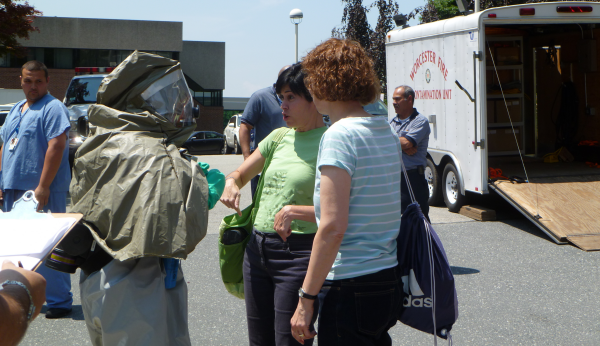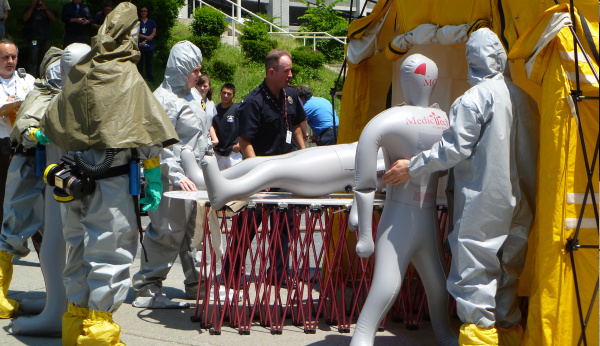The scene could have been quite chaotic. A school bus arrived at the UMass Memorial Medical Center Memorial campus with 40 people from a company picnic, some of whom were in a bad way after being doused with powdered chlorine by a disgruntled employee as he flew overhead in his antique biplane. They complained of many problems that called for urgent care, such as eye and skin irritation, difficulty breathing and vomiting, but they needed to be decontaminated before entering the hospital.
Adding to the confusion, some of the victims required special attention: one used a wheelchair, one communicated through sign language, one had a developmental disability and another carried a young child with leg braces.
But there was no chaos, even though members of the large team responding to this emergency came from all areas of the hospital, including members of the facilities staff who erected the decontamination tents, and many members of Worcester public safety departments. This particular incident turned out to be just a drill, but the responders were calmly following a well-orchestrated emergency plan, required of all hospitals so they will be as prepared as possible for an actual emergency.
What made this drill more realistic than most was the inclusion of volunteers from the Shriver Center in Waltham, some of whom have a disability (others were just playing the part). The goal of the group, led by Susan Wolf-Fordham, project manager at the Shriver Center, is to raise awareness about equal access for people with disabilities in emergency preparedness plans.
“We are giving important feedback for the emergency teams,” said Wolf-Fordham. “Having volunteer victims [with disabilities] means we are practicing for real, rather than practicing for easy.”
The yellow decontamination tents create a long tunnel where patients are moved along to receive a thorough decontamination shower. Two narrower tunnels on either side of the tent are for ambulatory people—one side for men and one side for women for privacy reasons. The larger middle part of the tent includes a long, waist-high conveyor belt, where people who need assistance, such as those in wheelchairs, are lifted onto backboards and rolled through the decontamination process on their backs. The fact that the center tunnel does not provide the same privacy as the ambulatory sections is an example of how the disabled community might be treated differently in the same situation.
Wolf-Fordham played several roles in the drill, including one as the mother of a child with a disability. Although she carried a doll in the drill, the situation is true to life—her daughter has a disability, which makes her acutely aware of the challenges that this population faces. “The more vulnerable you are on a good day, the way more vulnerable you are on a tough day,” she said.
“These are not only good learning experiences,” said volunteer Patrick Gleason, a Shriver employee who uses a wheelchair. Including participants with disabilities also means “putting people with disabilities forward as a valued population whose needs have to be considered when something like this occurs.”
In addition to Gleason and Wolf-Fordham, Teresa V. Mitchell, PhD, assistant professor of psychiatry, played the part of a deaf person who communicated solely through sign language. Nate Trull, a self advocate who runs workshops through the Shriver Center on emergency preparedness for people with disabilities, also participated.
Gina Smith, RN, director of emergency preparedness for UMass Memorial and team commander of the Massachusetts-2 Disaster Medical Assistance Team, said making the drill more realistic is just one way the volunteers with special needs help in the process.
“We can also get live feedback from them when we do our review session—what we have done and what we need to do better,” said Smith. “It is very enlightening to hear their point of view.”
For example, in this recent drill, the volunteers reported that it would have been difficult for a person with a visual or hearing impairment to understand what was going to happen to them—it was hard to hear instructions from the medical personnel who were wearing bulky decontamination suits. Having laminated written instructions, maybe in multiple languages in a large font, that could be handed out to patients might make that easier.
Smith and her team may incorporate those changes into a similar training drill on the UMass Memorial University campus on Wednesday, June 22—although for this drill, all the victims will be mannequins.
 Teresa V. Mitchell, PhD, center, uses sign language to communicate with emergency workers during a recent drill at UMass Memorial Medical Center Memorial campus. Susan Wolf-Fordham, right, observes. |
 Most of the victims in a recent emergency preparedness drill at UMass Memorial Medical Center Memorial campus were mannequins. |
Related links
Passionate advocate links community to Shriver Center
Lancaster pharmacist courts disasters
Pharmacist receives national honor for disaster work
Shriver Center
Other coverage:
NECN: Decontamination drill at UMass Memorial
T&G: UMass emergency drill includes disabled ‘victims'